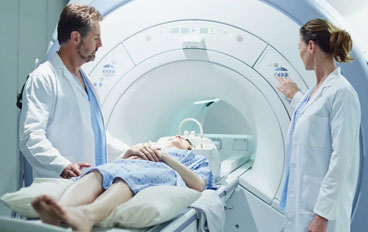MRI Scans
What is an MRI scan?
MRI (magnetic resonance imaging) is the name given to a technique which builds up pictures of an internal cross-section of the part of the body under investigation. The large machine is about four feet long and the area of interest is positioned in the centre. It uses a magnetic field and radio waves, together with an advanced computer system. It builds up a series of images, each one showing a thin slice of the area being examined. These images are very detailed. They can show both bones and soft tissues in the body and provide a great deal of information. Using the computer, the ‘slices’ can be also be obtained in any direction. MR images allow physicians to evaluate parts of the body and certain diseases that may not be assessed adequately with other imaging methods such as x-ray, ultrasound, or computed tomography (CT).

What happens during the MRI?
You will be taken into the MRI scan room and made comfortable lying on the couch. Pads and pillows may be used to help you stay still and maintain your position during imaging. You may be given an injection which helps to produce more detailed images. His will be will be injected into a vein in your arm, which occasionally causes a warm feeling for a short while. If this is required you may need to have a blood test prior to your scan. The couch will be moved slowly to position the part of your body being scanned in the centre of the scanner. The radiographers will retire to the control room but you will be able to talk to them via an intercom and they will be watching you all the time. It is important that you remain completely still while the images are being recorded. During the scan, you may well find the machine very noisy and you will be given ear plugs and/or earphones to use. If you feel uncomfortable or worried, do mention it immediately to the radiographer.
How long will it take?
The process of taking the images usually takes about 20–30 minutes and your total time in the department is likely to be about 45 minutes.
Are there any risks?
As far as is known at present, this is an extremely safe procedure. It does not involve the use of x-rays. You bodyare placed in a very powerful magnetic field. If you have any small pieces of metal inside your , you should inform the radiographer as in some cases you may not be able to have the examination. If you have a history of metal fragments in your eyes, you may need an x-ray done to prove there are no fragments remaining. If you have a pacemaker, metal heart valves or a metallic clip in your brain, there is a risk that these may be affected during an MR scan, and a different examination will need to be arranged instead. For female patients, if you are or might be pregnant, you must make sure the doctor referring you or a member of staff in the radiology department knows as soon as possible. MRI scans are not advisable in early pregnancy unless there are special circumstances.
When will I get my results?
As far as is known at present, this is an extremely safe procedure. It does not involve the use of x-rays. You bodyare placed in a very powerful magnetic field. If you have any small pieces of metal inside your , you should inform the radiographer as in some cases you may not be able to have the examination. If you have a history of metal fragments in your eyes, you may need an x-ray done to prove there are no fragments remaining. If you have a pacemaker, metal heart valves or a metallic clip in your brain, there is a risk that these may be affected during an MR scan, and a different examination will need to be arranged instead. For female patients, if you are or might be pregnant, you must make sure the doctor referring you or a member of staff in the radiology department knows as soon as possible. MRI scans are not advisable in early pregnancy unless there are special circumstances.
What happens during a pelvic ultrasound?
There are two ways in which a pelvic scan may be done. A trans-abdominal scan is performed in the same way as an abdominal scan; the only difference is your sonographer will place the sensor over your lower abdomen. A trans-vaginal scan is used to examine the womb, fallopian tubes and ovaries in more detail. You will need to lie on your back with your knees raised and your sonographer will insert a slim-line sensor (the size of a tampon) with a protective cover into your vagina. This procedure is safe to perform during a period (menstruation). The procedure isn’t painful, although it may cause slight discomfort. If you have a latex allergy, tell your sonographer so that he or she uses a suitable cover.
When will I get my results?
Your scan will be reported as soon as possibleand the report rapidly delivered to your referring practitioner. You should arrange to see your referring practitioner to discuss the results.
How long will it take?
The process of taking the images usually takes about 20–30 minutes and your total time in the department is likely to be about 45 minutes.
Are there any side-effects?
No. You can drive home afterwards and return to work as necessary.
Do I need to have any special preparation?
Unless told otherwise you don’t need to have any special preparation and may eat and drink normally before and after the scan.
Complaints procedure
We strive to always give our patients the best possible care. We will investigate any complaints from patients or their representatives thoroughly. If you are unhappy with the service or care we are providing please contact us at info@yorkshirehealthsolutions.com or telephone 0113 3854665.
